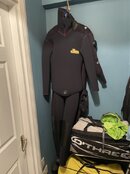I think balancing a rig according to the GUE definition with a thick wetsuit is mathematically impossible regardless of tank(s) used and weight distribution.
I'm using the numbers from my GUE materials - a wetsuit gives you +22 lbs of buoyancy at 10 feet and just 6lbs at 100ft. I also assume the gas in an AL80 cylinder weighs 6lbs.
One condition for a balanced rig is being able to hold a 10ft stop with near empty tanks. Let's make our diver neutral at 10ft with empty tanks. His wetsuit gives him +22lbs so he needs 22lbs of weight to counteract that. This includes the weight of the tank(s), backplate, regulators, light, fins, lead. Notably, this does not include the weight of the gas in the tank(s).
Let's check our buoyancy at 100 feet with full tanks. We'll be negative of course, but how negative? We lose 22-6 = 16 lbs of buoyancy from the wetsuit. We also need to add 6lbs for the weight of the gas, assuming we're diving a single AL80. If we're diving more/bigger tanks, the math gets worse. So overall, we're at least 22lbs negative at 100 feet.
We can't swim 22lbs up so we need to drop some weights. The problem is we're neutral at 10feet so any weight we drop will make us positive. So if we drop 10lbs of weight, we'll be 10lbs positive at 10 feet and we can't hold our last stop.
This gives a hand-wavy proof of a more general necessary condition for a balanced rig (I won't bore you with the full proof but the idea is the same):
Where:
- buoancy_loss_from_10_to_100_feet (lbs) - how much buoyancy our exposure protection loses at depth
- weight_of_gas_in_tanks (lbs) - total weight of gas in our tanks
- weight_we_can_swim_up (lbs) - amount of negative buoyancy we can swim up from 100 feet with a failed wing. Note: this is different from amount of lead weight we can swim up. This means we're neutral at 100 feet and we add weight_we_can_swim_up lbs more.
- positive_buoyancy_at_10_feet_we_can_handle (lbs) - how much positive buoyancy we can handle at 10ft and still hold a somewhat comfortable stop.
Am I missing something? Is my math wrong?





